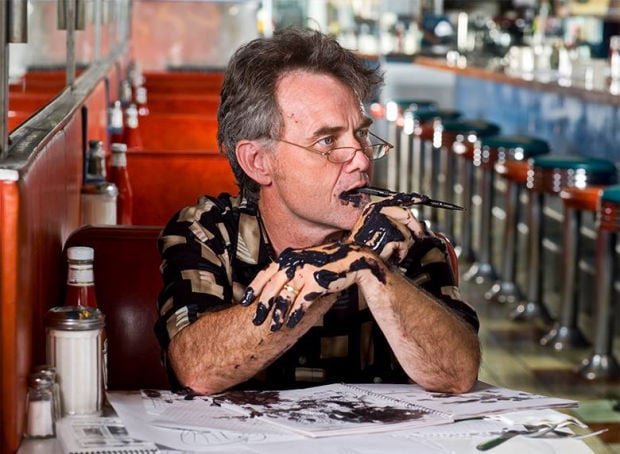For two weeks we toured southern Germany’s castles, beer gardens and Gothic cathedrals with another family. I’d been to Busch Gardens and Ikea but this expedition to the old world was the trip of a lifetime for this hillbilly. If you think a Dodge Ram was Built To Last you’ve never seen a 10th century Gothic cathedral.
I experienced only one setback. A Type 2 diabetic, I thought I’d treat myself to nonalcoholic beer at every beer garden we visited. Lesson learned. After our fifth beer garden and too many cathedral bells I joined a Bavarian chapter of Non-Alcoholics Anonymous.
By day we toured the palaces of all-powerful absolute rulers who were convinced they were vetted and endorsed by God. By night I read my summer indulgence, Sarah Vowell’s “Lafayette in the Somewhat United States,” a wisecracking biography of the 20-year-old French revolutionary who helped General Washington’s Army kick the King’s redcoats and their old world ideas back across the pond.
This very American rejection of anti-democratic rule is what I like to believe the folks on the plane were applauding when we touched down at O’Hare at the end of our European vacation.
But, I’m not so sure.
As I stood in one grandiose cherub-filled palace after another, built to amuse one more infantile monarch, a clapboard house in the American Midwest came to mind. Your Majesty, you ought to see Harry Truman’s home in Independence, Missouri, if you want to see the simple splendor of rough-hewn liberty.
A post I regretted reading on vacation noted that our President had called our humble and plain-spoken White House, The People’s House, a “dump.” A dump? Hungering for chandeliers and pomp, our Sun King doesn’t have a clue what the American revolution was about.
After bouncing around Bavaria we zipped on the autobahn into Munich, the beautiful gilded-age cosmopolis that spawned the rise of the Nazi party. In the 1930s, Hitler found in Munich a resentment-sotted people craving national pride, a mythic destiny and scapegoats for their woes.
And, in Munich, I found heroism.
My first pilgrimage was to the University of Munich to see a memorial sculpture devoted to Sophie Magdalena Scholl, a 21-year-old college student who was beheaded in Stadelheim prison the same day she was found guilty of the high crime of distributing her leaflets criticizing the Nazis.
Facing the guillotine Sophie spoke. “Such a fine, sunny day, and I have to go, but what does my death matter, if through us, thousands of people are awakened and stirred to action?”
All regimes that fear mere words, ink on paper, lack faith in their people and will never endure. Centuries before, our American revolutionaries understood that dynamic when they determined the very first amendment in our Bill of Rights would protect free speech, and a free press, from the tyranny of those who would tremble before criticism.
Miss Scholl’s essays were smuggled out of Nazi Germany into the hands of the Allies who reprinted them by the thousands. From the air the Supreme Allied Command rained her words down on Germany. Today, Sophie’s flyers, etched in eternal bronze, are embedded, like school papers scattered by the wind, among the cobblestones in front of the university.
The same day Hitler killed himself in Berlin a convoy of American jeeps, led by a German-born GI, Lt. Wolfgang F. Robinow, rolled into what was left of Munich’s Marienplatz, the main square where they were welcomed by a small group of very old people and very young children.
Robinow’s school roommate had been a Jew; Dachau, a few miles to the west, had just been liberated. Robinow was disgusted at the sight of the ragged survivors. Not a soul among them claimed to have ever worn a “Make Bavaria Great Again” cap.
Germany was rebuilt under the Marshall Plan, devised at Rancho de la Osa in Sasabe, Arizona. And Wolfgang? He returned to Germany, to live out his life in Hamburg.
How could such barbarism have taken root in a modern industrialized democracy? Acknowledging its Nazi past, Munich’s impressive Documentation Museum answered this question in terrifying detail. After hours spent among the exhibits chronicling Germany’s descent into madness I found myself in front of looping Allied footage of acres and acres and acres of German rubble. Ashamed of the perverse satisfaction I felt at the sight of the complete annihilation of the Nazi party’s home base, cathedrals and all, I strolled with my wife and friends to a lovely beer garden, alive with hipsters, tourists and locals enjoying fine food, music and laughter on a beautiful Munich afternoon, on what I’m certain Miss Scholl would describe as a fine, sunny day. Contact editorial cartoonist and columnist David Fitzsimmons at tooner@tucson.com





